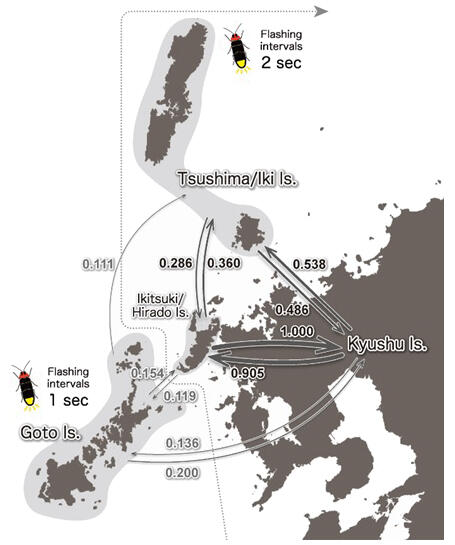The Genji fireflies that breed on the Goto Islands, remote islands of Nagasaki Prefecture in Kyushu, were found to rarely interbreed with the Genji fireflies living on the Kyushu mainland. A research group consisting of Associate Professor Shin-ya Ohba of the Faculty of Education and Graduate Student Naoki Hiraishi (at the time of research) of the Graduate School of Education at Nagasaki University, and Assistant Professor Tomoya Suzuki of the Faculty of Human Environmental Studies at Hiroshima Shudo University carried out a detailed genetic study of the Goto Islands Genji firefly, which has the fastest flashing frequency (once per second) of all fireflies in Japan. They found that the Goto Islands fireflies are becoming genetically distinct from the Western Japan type (which flashes once every 2 seconds) distributed across the Kyushu mainland. The Goto Islands firefly population was also found to have much fewer genetic relationships with the Western Japan type population than those on other remote islands. The findings suggest that Genji fireflies of different populations have difficulty communicating with each other when they encounter unique flashing patterns, and the populations distributed only on the Goto Islands have genetic characteristics distinct from those of other populations. The study findings were published in the Biological Journal of the Linnean Society.

Provided by Nagasaki University
Genji fireflies on the Goto Islands were reported in 2020 as endemic on the islands (distributed throughout the Fukue, Hisaka, Wakamatsu, Nakadori, and Ukujima Islands), and their flashing pattern is the fastest of all fireflies in Japan. Analysis of the cytochrome c oxidase subunit II (COII) region of the mitochondrial DNA alone suggested that the Goto Islands type is a different population from the Western Japan type on the Kyushu mainland. However, because Ukujima Island is at the northernmost part of the Goto Islands and closest to the mainland in distance, and the Ukujima Island firefly population is included in the Kyushu mainland type (flashing once every 2 seconds), it was necessary to clarify the genetic relationship of the Ukujima type (flashing frequency of one per second, equal to that of the Goto Islands type).
In this study, the ND5 region of the mitochondrial DNA was added to the analysis, and a large volume of nuclear DNA polymorphism information (obtained with the GRAS-Di next-generation sequencer) was incorporated. The researchers then investigated in detail the relationship between the Goto Islands and Kyushu mainland firefly populations. As the result of the mitochondrial DNA analysis, the Goto Islands population was estimated to have differentiated genetically from the Kyushu mainland population approximately 1 million years ago. The analysis of the nuclear DNA polymorphism information further revealed that the Ukujima population, distinct from the Kyushu mainland population, is included in the Goto Islands population.
These results suggest the following: (a) flashing of once per second evolved within the population after it moved from the Kyushu mainland to the Goto Islands; (b) subsequently, almost no genetic interaction occurred between the Goto Islands population and the Western Japan population on the Kyushu mainland (flashing every 2 seconds); and (c) the Goto Islands population is still undergoing speciation.
This article has been translated by JST with permission from The Science News Ltd. (https://sci-news.co.jp/). Unauthorized reproduction of the article and photographs is prohibited.




